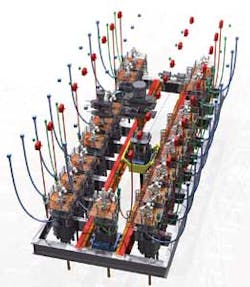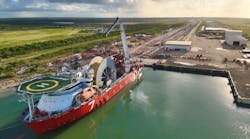If you were not among the more than 104,000 attendees at the 2013 Offshore Technology Conference, you missed an excellent show. Several themes were addressed, not the least of which was the perennial specter of the "Great Crew Change" that has threatened the industry for years. At last, we are seeing evidence of organized efforts to mitigate the potential shortage of trained recruits to fill the technical ranks thinned by retirements. The efforts are none too soon because the industry is experiencing global growth. As usual, technology has helped by making many labor-intensive workflows less so. For example, immense computer power has enabled more data to be processed faster than ever before. This is particularly noticeable in exploration, where massive seismic files that once required months of processing time can now be delivered to geoscientists ready for interpretation within a few days.
Academia has risen to the challenge. One recent initiative was announced by Dr. Bowen Loftin, president of Texas A&M University. Called "25-for-25," the objective of the program is to grow the student population of the university's Dwight Look School of Engineering from its present 10,000 enrollees to 25,000 by 2025. Admittedly an aggressive move, the idea may create some critics, but those are people unacquainted with the university's reputation for delivering on its promises. With its strong industry affiliations, the Look School, for one, has definitely listened to our concerns for well-trained engineers to replace those retiring from our ranks. Where one leads, others will surely follow.
But education of tomorrow's talent does not begin magically at the university level. Countless young people never get to study curricula complementary to oil and gas industry positions because they lack the pre-requisites for admission. This year, the OTC recognized the education outreach program of the Offshore Energy Center as beneficiary of a portion of the proceeds of the OTC Awards Dinner. Starting as early as kindergarten, the OEC education outreach programs are dedicated to expanding the awareness of the vast energy resources beneath the world's oceans. By developing science and technology lessons in accordance with national standards, the program promotes the past, present, and future importance of the offshore energy industry and its many contributions to our quality of life. Youngsters learn scientific principles as they apply to the exploration for and production of hydrocarbon resources that supply the bulk of the energy needs of the world. By making learning fun, the program encourages the natural curiosity of the students to pursue options that will prepare them for advanced education opportunities in the energy sector. An aggressive program of teacher workshops complements the lesson plans and material supplied to the students by showing teachers how to get the most benefit from the program.
Technology developers were encouraged by having their efforts recognized on the OTC's world stage. This year's OTC Spotlight on New Technology awards honored 15 of the latest innovations, all of which could be seen in the exhibit halls. Two companies, FMC Technologies and GE Oil & Gas, were double winners. Innovations addressed a wide spectrum of offshore activities. All were impressive.
This author has always believed that awards programs are somewhat subjective. Beauty, after all, is in the eye of the beholder. Accordingly, one of the winners caught my attention more than the others. This is not to cast aspersions on the others, all of which are worthy winners. In fact, I liken my choice to the Miss America Pageant. One candidate gets the tiara and the bouquet of roses, but the other 49 are not bad.
With the above disclaimer, this author wants to identify the Drilling Riser Trip Saver from SBM Offshore as his favorite. Compatible with SBM's Dry Tree Tension Leg Platform deepwater production facility, the Drilling Riser Trip Saver saves both time and money while offering an intrinsically safe well-construction approach. Using a rail-mounted transport system, a suspended drilling riser complete with riser tensioning system and surface blowout preventer in place can be relocated on a grid to enable multi-well drilling of subsea wells consecutively. It is a perfect solution for a field development program because it offers both efficiency and flexibility to the operator. Risk is mitigated by alleviating the need to remove the suspended drilling riser from the well bay.
Because the system removes the dropped object hazard from the well bay, operators using the technology can continue drilling operations on new wells without shutting in previously drilled and completed wells. It accomplishes this by alleviating the need to recover and redeploy the drilling riser in close proximity to live producing wells. Typically, operators were required to experience production downtime not only while the drilling riser was being repositioned, but for a lengthy cool-down and restart period for those wells that were shut in.
The system uses a "factory" approach, where the first step is to drive conductors into the seabed in an established pattern according to field development plans. For each well, after drilling the surface hole riser-less, using seawater, surface casing is set and the subsea wellhead is installed. Then, using a procedure where a ROV attaches dual guidelines to the subsea wellhead guide base, the drilling riser is guided to the subsea wellhead, where it is mated up and conventional drilling commences. The technology saves considerable time during the drilling operation and lowers costs by reducing wear and tear on the drilling riser. The rail-mounted transport system allows the Drilling Riser Trip Saver to be positioned at a large number of positions over the well bay of the drilling vessel without having to recover and re-deploy it between wells. After each well is drilled and cased, a production riser is then installed, providing direct vertical access to the well in order to install the production tubing, surface wellhead, and surface production tree staged on the lower production deck well above the air gap. Completion can be accomplished singly or in batches as desired.
The flexibility and efficiency of the system is complemented by the reduced safety risk from the minimization of dropped object hazards.







